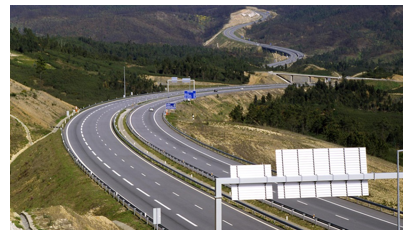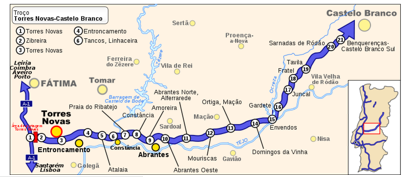Case Studies: A23 Beira Interior, Portugal
Contents
Introduction
Motorway A23 – Beira Interior (E 806) crosses the regions of Guarda, Castelo Branco, Portalegre and Santarém, connecting Torres Novas (on motorway A1) to Guarda (on motorway A25). It is Portugal’s third longest motorway – with a length of 217 km – and is considered a key structural component of the national road network asit offers thefastest connection to the Spanish border atVilar Formoso from the capital, Lisbon.
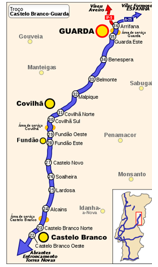
Figure 2: A 23 – Beira Interior (E 802 / E 806)
Motorway A23 – Beira Interior has two lanes in each direction, with an extra overtaking lane in sections with steeper gradients. Construction was concluded in 2003. The project incorporated some sections of the IP 6 (between Torres Novas and Abrantes) and the IP 2 (between Alcains and Fundão) roads, which form part of the national main road network.
The section between Abrantes and Guarda (178 km) is under concession. SCUTVIAS (Auto Estradas da Beira Interior, S.A.) was assigned the design, construction, operation and maintenance for 30 years. The remaining section, Torres Novas toAbrantes, is the oldest and most winding (especially near the Rio de Moinhos junction) and is managed by the national road institute (Instituto das Estradas de Portugal – IEP, S.A.).
No user tolls were initially charged in order to promote development in the region. An electronic tolling was implemented throughout the A23 motorway as of December 2011.Less attractive no-toll alternatives to the A23 motorway are the lower standard N243, N3 and N18 roads.
The Contracting Authority (Public Party)
The project is part of the national road plan and was initiated with a Government Decree.The Ministry of Public Infrastructure, Planning and Territorial Administration (Ministério do Equipamento, do Planeamento e da Administração do Território – MEPAT) was responsible for the process,along with the Finance General Auditor (Inspecção-Geral de Finanças – IGF).
Regulatory requirements concerning road design, construction, operation and maintenance were determined bythe National Road Institute (Instituto das Estradas de Portugal S.A. – IEPS.A.) and, as of 2007, the Instituto de Infra-Estruturas Rodoviárias (InIR, I.P.).
The Concessionaire (Private Party)
The concession for the A23 – Beira Interior motorway was awarded to SCUTVIAS (Auto Estradas da Beira Interior, S.A.), a consortium of Portuguese companies including:
- Soares da Costa Concessões / Intevias (22,22%). Its core business is construction (77.5% of 2011 turnover) as well as civil engineering, real estate, housing construction, production of construction materials and otheractivities including financial services. Concessions represented 21% of its 2011 turnover). The group operates in Portugal, Angola and Mozambique.
- ES Concessões, S.G.P.S., S.A.(22,22%), a subsidiary of the Banco Espirito Santo group. This is a holding company, which manages the group’s shares in transport infrastructure concessions. It is part of the Ascendi group, which holds interests in several road and rail concessions in Portugal, Spain, Mexico, Brazil and Mozambique. In Portugal these include the two Lisbon bridges and the Lisbon south bank light rail.
- Global Via, Consultores de Engenharia, S.A.(22,22%).This is a consulting company specializing in designand operation of transport engineering projects.
- Alves Ribeiro, S.A.(33,34%).This is a construction company operating in Portugal, Angola and Brazil. Its core business is engineering and construction, namely of public works, roads, airports, water supply systems and residential and office buildings.Other business areas include management, property development and road concessions.
Design and construction works were contracted to ACESTRADA (Construção e Estradas ACE) composed of:
- Soares da Costa (20%);
- Teixeira Duarte (20%);
- Grupo Dragados (20%);
- Sopol (13.34%);
- Alves Ribeiro (13.33%);
- Ramalho Rosa Cobetar (13.34%).
The financing structure is highly leveraged, with 9.4% of financing through equity and 90.6% from debt financing, partly from the European Investment Bank and partly from a syndicate of 26 international banks.
Users
The motorway serves regional and international traffic. The relatively high density of exits allows for short-distancetraffic in some areas as well as a long-distance inter-urban traffic. As part of the trans-European transport network, it also serves international users travelling from/to Spain via the E80 motorway.
The Average Daily Traffic (ADT) peaked in August 2010 at approximately 14.000 vehicles (see Figure 3).
The A23 motorway was initially opened as a shadow toll road but since December 2011 electronic user tolling has been introduced. Users are charged on their electronic tolling device. Alternatively, they are photographed and their bill is sent via the National Post; it is payable at any post office within five days of receipt.
Key Purpose for PPP Model Selection
Government Decree 267/1997 introduced the possibility of shadow toll PPPs and determined thedelivery model of the A23 – Beira Interiormotorway.
More specifically, project finance was introduced to speed up the implementation of the National Road Plan (Plano Rodoviário Nacional) and increase the supply of toll free road infrastructure.
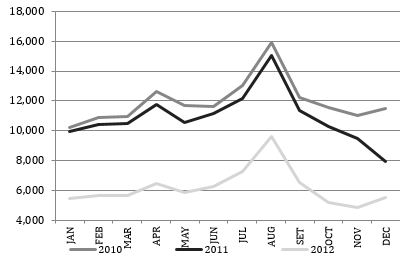
Figure 3: Actual average daily traffic 2010 - 2012
Source: Instituto de Infra-Estruturas Rodoviárias (InIR, I.P.) Traffic Reports 2010-12
Project Timing
The project was implemented as part of the IP2 and the IP6 routesin the national main road network, in a region with a low quality road network and medium-sized cities with growth potential based on industrial and agricultural production, administrative functions and higher education institutions. The economic crisis had an impact on the Government’s ability to pay shadow tolls, and in December 2011 user tolls were introduced.
Project Locality and Market Geography
Motorway A23 – Beira Interior (E 806) crosses the regions of Guarda, Castelo Branco, Portalegre and Santarém, connecting Torres Novas (on motorway A1) to Guarda (on motorway A25).It therefore providesa link between urban agglomerations situatedbetween motorways A1 (Lisbon– Porto) and A25 (Beiras Litoral –Alta).
Moreover, the A23 motorway forms part of the national main roads IP2 (national north-south central axis road) and IP6 (national east-west central axis), and provides access to the E80 (Spain).
Procurement & Contractual Structure
Tendering
The tendering process followed a two-stage approach corresponding to a “long list”and a “short list” phase.
In the long list phase compliant proposals were analyzed with respect to two sets of weighted criteria. The first (accounting for 65-70% of the score)included the net present value (NPV) of the financial cost of the concession to the State, the risks associated with this NPV, and the infrastructure delivery deadlines.The second set(30-35% of the score) included the financial, organizational and contractual soundness of the bidder, the degree of commitment of other entities the bidder intended to involve, the quality of the proposal in terms of conception, construction and operation, service levels and the road safety plan.
The two best bids were selected to continue to the “short list phase”, which involved a parallel negotiation process with each bidder and the submission of a best and final offer. The concession contract was awarded to SCUTVIAS.
Contract Structure
The concession contract for the A23 – Beira Interior motorway was signed in September 1999 with a 30-year duration. Its objectives include:
- Design, financing and construction of:
- three motorway sections: Alcaria – Teixoso (IP2), Teixoso - Guarda (IP2), and Mouriscas - Gardete (IP6);
- lane duplication in the motorway section Gardete - Castelo Branco IP2);
- motorway Túnel da Gardunha (IP2);
- service areas.
- Operation (including accident assistance and data collection) and maintenance of:
- Alcaria - Teixoso (IP2);
- Teixoso - Guarda (IP2);
- Mouriscas - Gardete (IP6);
- Alcaria - Teixoso (EN18).
The contract establishes the rights and obligations of the private and public parties, and the framework of risks, costs and incentives as well as the transfer of ownership rights. At the end of the concession period, the asset ownership will return to the State at a maintenance standarddefined in the contract.
A fixed availability fee was foreseen for the first stage of the concession (during construction, or roughly five years) depending on the length of road in operation. During this same period, remuneration for new motorway sections included a fixed availability payment and a variable payment depending on traffic, road length, duration of operation, and a shadow toll defined bythe State on an annual basis.
Three levels of shadow tolls weredescribed according to trafficbands. For lower traffic bands, higher tolls were to be paid, while the higher traffic bands corresponded to lower tolls.
The tolls were also structured in three parts: the first would pay for fixed operation and maintenance costs and senior debt; the middle part would pay for variable operation and maintenance costs and subordinated debt; and the third part would cover dividends and stockholders debt.
After the first stage of the concession, the contract foresaw remuneration based on an annual variable sum depending on traffic volume and type (proportion of heavy vehicles), availability and a shadow toll defined by the State on an annual basis. Incentives were foreseen for low road accident indices, with penalties for low availability.
Following contract renegotiation, user fees / tolls were introduced in December 2011. According to the Directorate-General of Treasury and Finance (DGTF) remuneration is now based on availability.
The original contract also included financial rebalancing payments in the following situations:
- changes in concession activities introduced unilaterally by the State leading to increased costs or reduced revenue for the private partner;
- force majeure events;
- legislative changes which increase costs or reduce revenues;
- other relevant situations.
The following three key indicators were to be used as the basis for financial rebalancing:
- A minimum annual debt service coverage ratio;
- A minimum loan life coverage ratio;
- A minimum internal rate of return for the shareholders.
Security guarantees of at least PTE 500M (EUR 2.5 M) were issued in favour of the State. During construction, the guarantee was set at 5% of the annual construction budget reduced 1% of its reversible tangible asset value, following the completion of each section, respectively.
The guarantee was finally set at 1% of the reversible tangible asset value of the newly constructed road section. This is adjusted annually by the consumer price index.
The concessionaire is also obliged to effectively and comprehensively insure against risks involved in the concession activities, including its own risks. The SPV shareholders are also bound by the concession contract to issue a bank guarantee in favour of the SPV for the full amount of their respective equity. ACESTRADA, the design and construction sub-contractor, was also obliged to issue a guarantee.
Staged construction is also included in the contract, with the addition of lanes following a renegotiation when traffic reaches certain levels.
Risk Allocation
The contract states “the private partner bears full and exclusive responsibility for all the risks associated with the concession except when the opposite results from the concession contract”.
In 2012, the Directorate General of Treasury and Finance (DGTF) published PPP risk matrices. Figure 4 summarises this report, which represents the situation following the renegotiation concluded in December 2011.
Performance
In the first years of operation actual traffic was below forecasts, according to reports published by the Road Institute (Figure 5). Traffic volumes following the recession are presented in Figure 3, where a considerable drop in traffic is witnessed in 2012, after the introduction of tolls in December 2011.
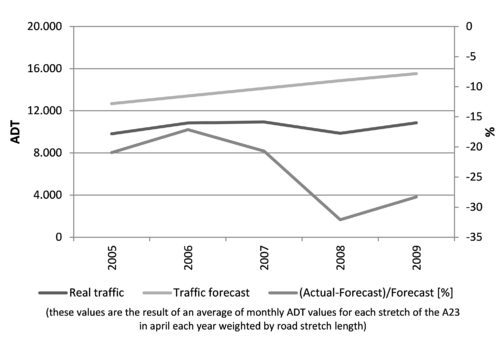
Figure 5: Actual and forecast average daily traffic
Source: Road Institute
The concession contract explicitly mentions two performance indicators: Availability and Road Accidents.
Availability is measured by an indicator of supply disruption. Supply disruptions are measured in lane-km x hours per year.
Road safety is measured by a road accident index defined by the contract:
Where:
- ISt(BI) is the road accident index for year t on the A23 road concession;
- Nt is the number of accidents with victims registered by the police authority;
- L is the total length of road in operation in that year;
- AADTt is the average annual daily traffic for year t, on the concession.
This index is compared with an average index ISt-1(weighted) which considers road accidents on all the shadow toll concessions in the country, ISt(SCUT), and the road accidents on the A23 concession the previous year, ISt-1(B1). The comparator is defined below:
Where:
- ISt(concession SCUTi) is the road accident index for each of the national shadow toll road concessions i in year t;
- Li is the total length of road in operation for shadow toll road concession i in year t.
Penalties are associated with low availability and higher road accident indices, as shown in Figures 6 and 7, respectively. Penalties are updated according to the consumer price index.
| Day-time (7am-9pm) | Night-time (9pm – 7am) | |
|---|---|---|
| Threshold | 30,000 lane-km-hrs/year | 50,000 lane-km-hrs/year |
| Penalty | 5,000 EUr per 1,000 lane-km- hrs/year | 2500 EUR/ 1,000 lane-km- hrs/year |
Figure 6: Unavailability Threshold
| Penalty Threshold | ISt(BI)>ISt-1(ponderado) |
|---|---|
| Penalty | 
|
| Bonus Threshold | ISt(BI)<ISt-1(ponderado) |
| Bonus | |
Note: Pt is the shadow toll payment due to the private partner for year t
Figure 7: Road safety penalties and bonuses
Finally, the concessionaire is contractually obliged to produce two manuals:
- An operation and maintenance manual determining the rules, principles and procedures applied to vehicle counting equipment, CCTV, information and user relations policy, statistics to be supplied to the State, procedures for supply restriction situations, surveillance and emergency protocol and charges, environmental monitoring and control and service areas.
- A quality control manual determining the assessment criteria, measurement frequency, minimum standards and replacement protocol for each road (from pavement to telecommunications).
The public partner approves the manuals.
References
- Resolução do Conselho de Ministros n.º 93-A/1999 Draft contrac tmade public on20 August 1999 http://dre.pt/pdf1sdip/1999/08/194B04/00440073.pdf
- Court of auditors (2003). Report on shadow toll roads. http://www.tcontas.pt/pt/actos/rel_auditoria/2003/14-2003.pdf
- Court of auditors (2008). Report on road concessions. http://www.tcontas.pt/pt/actos/rel_auditoria/2008/audit-dgtc-rel010-2008-2s.pdf
- Directorate General of Treasury and Finance (2012). Annual report on PPPs
- Directorate General of Treasury and Finance (2010). Data sheet on A23
- DGTF’s data sheet on the A23 (2010):
http://www.dgtf.pt/ResourcesUser/PPP/Documentos/transportes/tr_beirainterior.pdf
- Government decree declaring the A23 road would be implemented and operated as a PPP, published in 02-10-1997 (Decreto-Lei n.º 267/97, de 2 de Outubro):http://dre.pt/pdf1sdip/1997/10/228A00/53905393.pdf
- Instituto de Infra-Estruturas Rodoviárias. Relatório de Tráfego (TrafficReport). Annual, 2008-13
- Cardoso, P.M.P.C (2011).Renegociaçãocontratual de parceriaspúblico-privadas no sector rodoviário. Dissertation submitted as partial requirement for the degree of Master of Civil Engineering. Instituto Superior Técnico. Universidade Técnica de Lisboa.
https://fenix.ist.utl.pt/dissertacoes/254634
- Vaz, I. A. S. (2011).As parcerias público-privadas: o caso da Scutvias. Case study submitted as partial requirement for the degree of Master in Management. ISCTE Business School.Instituto Universitário de Lisboa. http://repositorio-iul.iscte.pt/bitstream/10071/4086/1/Tese%20de%20Mestrado%20PPP_%20In%C3%AAs%20Vaz.pdf
- Special purpose vehicle website, visited in May 2013:
- Special purpose vehicle annual accounts and report for 2009:
http://www.scutvias.pt/dados/rc/RC2009/rc2009_PORT.pdf
- Special purpose vehicle annual accounts and report for 2010:
http://www.scutvias.pt/dados/rc/RC2010/rc2010_PORT.pdf
- J. Costa, R. Couchinho, J.Ribeiro, R. Macário, 2014, A23- Beira Interior, in A. Roumboutsos, S. Farrell and K. Verhoest, COST Action TU1001 – Public Private Partnerships in Transport: Trends & Theory: 2014 Discussion Series: Country Profiles & Case Studies, ISBN 978-88-6922-009-8
